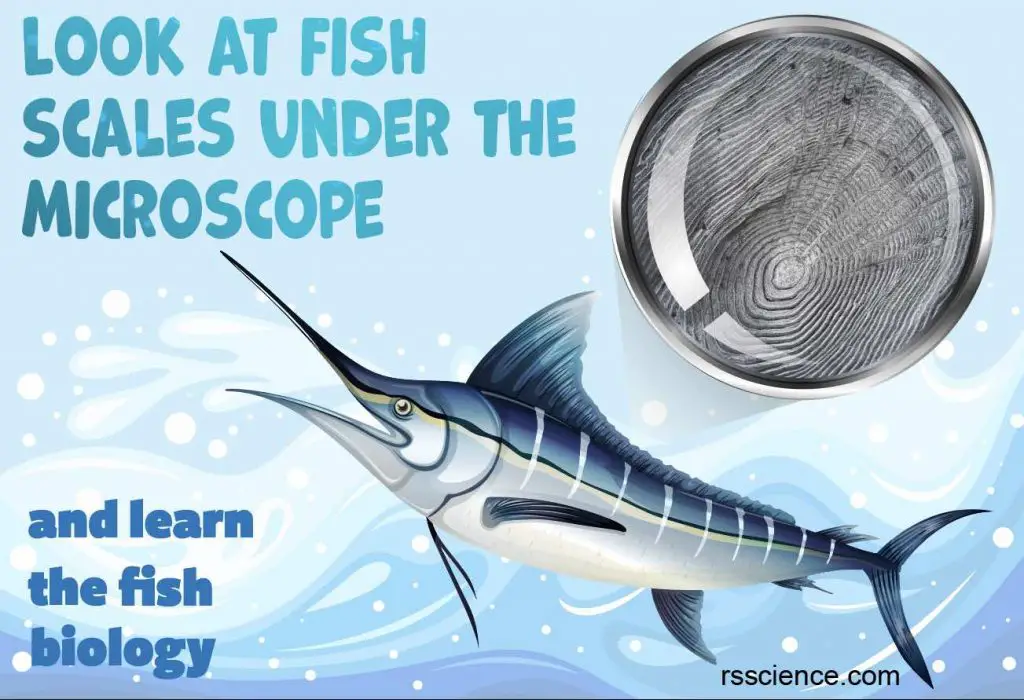Do you like to eat fish? Deep-frozen fish fillets coated with breadcrumbs are my favorites. Filet-O-Fish is no doubt my Top 1 item on the McDonald’s menu.
To be honest, I sometimes forget that this rectangular piece of a delicious meal is made of “fish”. Thank the chef (or your mom) in the kitchen who has done all the difficult work for us (i.e., removing fish scales and spines), so we can enjoy the taste of fish.
Many kids don’t like to eat fish. Maybe playing with some scientific projects, like observing fish scales under a microscope with your kids, could be an excellent way to restore friendly relations between children and fish 🤣.
Today, we have a chance to look at a fish before it is served at your dinner table. We will learn about the biology of fish and dive into the beauty of fish scales under the microscope. Are you ready?

[In this image] Fish or Fishes?
Photo credit: Woodward English
This article covers
Fish biology – a quick overview
Fishes are aquatic vertebrate animals. They have a central backbone to support their bodies and breath by the gills. With 34,300 described species, fishes exhibit greater diversity than any other group of vertebrates. Fishes can be found in nearly all aquatic environments, from high mountain streams to the deepest oceans.

[In this image] The great diversity of fishes.
Image source: wiki
Classification of Fish
We can simply divide fishes into three groups:
- Agnatha (jawless fishes) – These eel-like ancient fishes don’t have a jaw; instead, their mouths look like suckers. They also lack paired fins and scales. Many species were extinct. Two groups that still survive today are the lampreys and the hagfish.
- Chondrichthyes (cartilaginous fishes) – This group includes sharks, skates, rays, and chimaeras. They have soft skeletons primarily composed of cartilage. They also have paired fins and tooth-like scales.
- Osteichthyes (bony fishes) – These fishes have skeletons made of hard bone tissue. The vast majority of fish are members of Osteichthyes. They are also the largest class of vertebrates.
The group Osteichthyes is divided into the ray-finned fish (Actinopterygii) and lobe-finned fish (Sarcopterygii). Most fishes we find today belong to Actinopterygii.
Sarcopterygii fishes are ancient, and many of them were extinct. Their fins evolved into the legs of the first tetrapod land vertebrates – amphibians. Examples of living Sarcopterygii fishes are the coelacanths and lungfish.
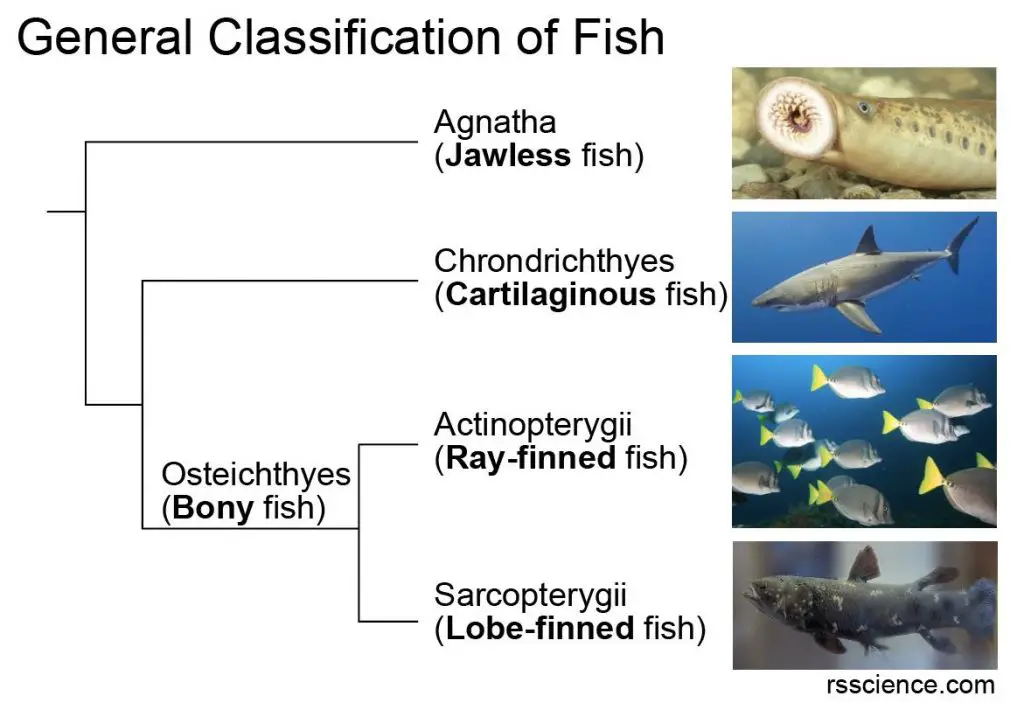
[In this image] The general classification of fishes. Note that most fishes we see now are either Chondrichthyes (i.e., shark) or Actinopterygii (i.e., swordfish). Many species in Agnatha or Sarcopterygii were extinct and could only be found in fossils.
Evolution of fish
The earliest fishes we found were eel-like jawless fishes (called the conodonts) about 530 million years ago during the Cambrian explosion. In the Devonian period, a tremendous increase in fish variety occurred, including all kinds of lobe-finned fishes and sharks. For this reason, the Devonian is known as “the Age of Fishes.” Meanwhile, some fishes evolved their lobe fins into walking limbs and eventually became the first four-limbed vertebrates. You can say that fish is the ancestor of all amphibians, reptiles, mammals, and birds today.
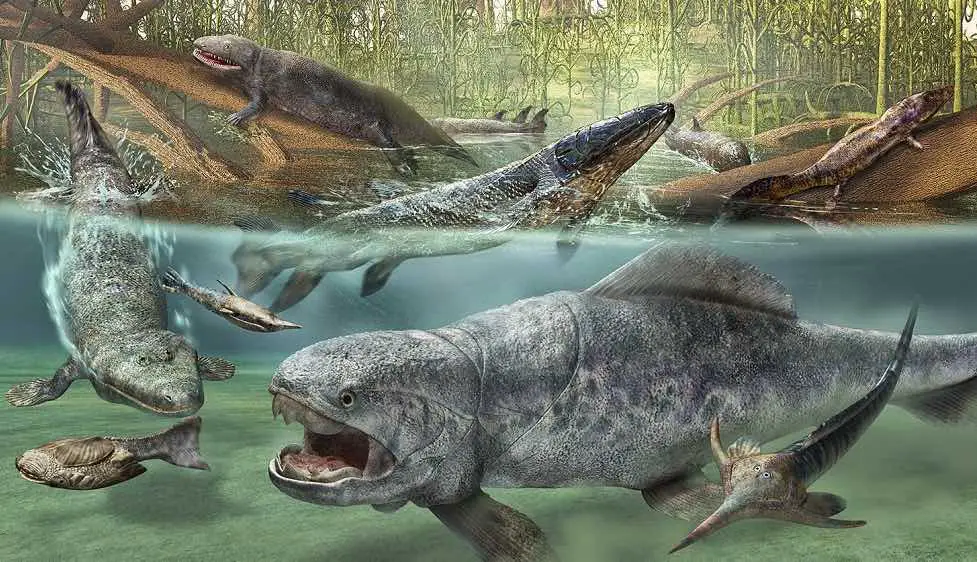
[In this image] The Devonian Period is a geological time that started about 419 million years ago and ended approximately 360 million years ago. There was significant evolutionary activity in jawed fishes during the Devonian Period. At the same time, some fishes transited to living on the land by evolving their lobe fins into walking limbs.
Image credit: Newdinosaurs
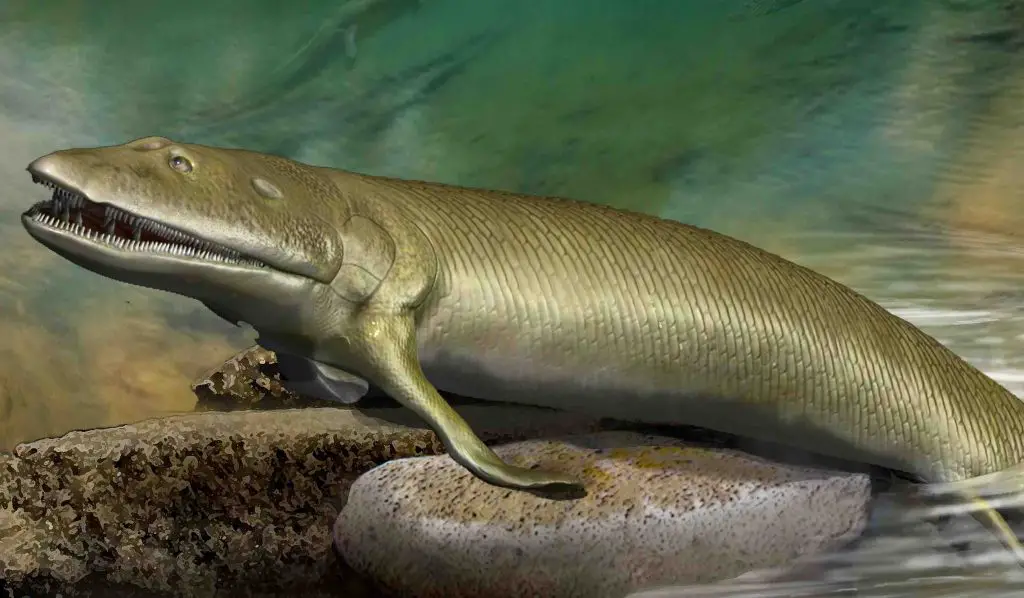
[In this image] An illustration showing the ancient fish, Elpistostege watsoni (380 million years old), which had finger bones in its front fins. The fossil was discovered in the Miguasha National Park in Quebec.
Image credit: Ecology & Evolution
Anatomy of Fish
The following illustration is for the common external and internal features of a typical bony, ray-finned fish.
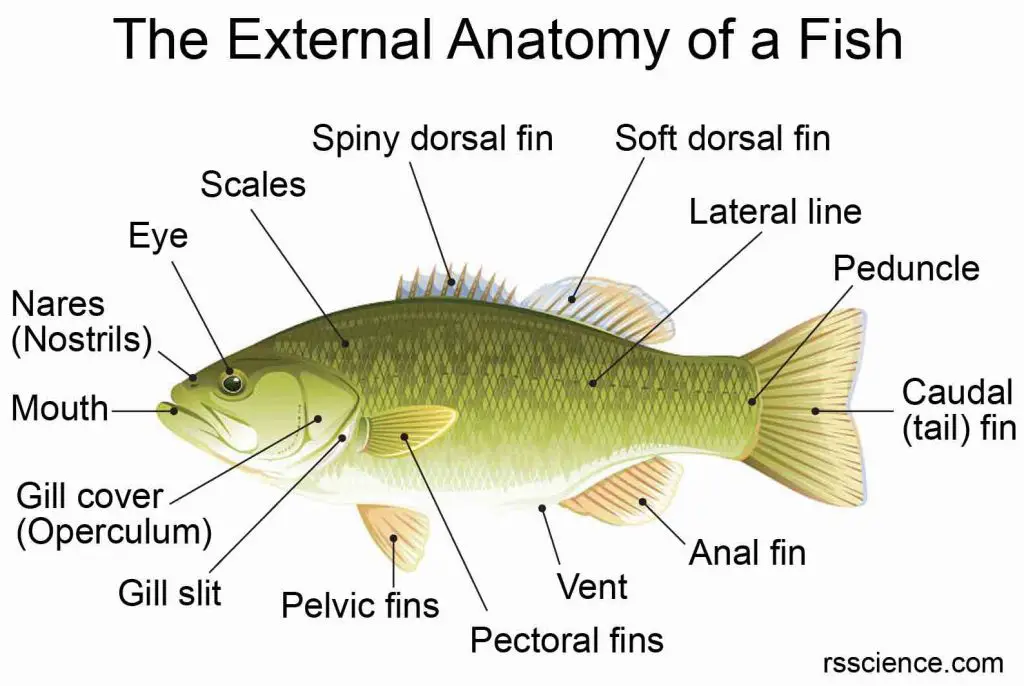
[In this image] External Fish Anatomy – This illustration of a bass shows some of the common exterior features of fish.

[In this image] Internal Fish Anatomy – Here shows the common internal organs of fish.
Here are short descriptions of unique organs in fish:
Fins
Fins are appendages used by fish to move. They are either single fins along the centerline of the fish, such as the dorsal (back) fins, caudal (tail) fin, and anal fins, or paired fins, which include the pectoral (chest) and pelvic (hip) fins. Fins are composed of bony spines or rays covered with skin.
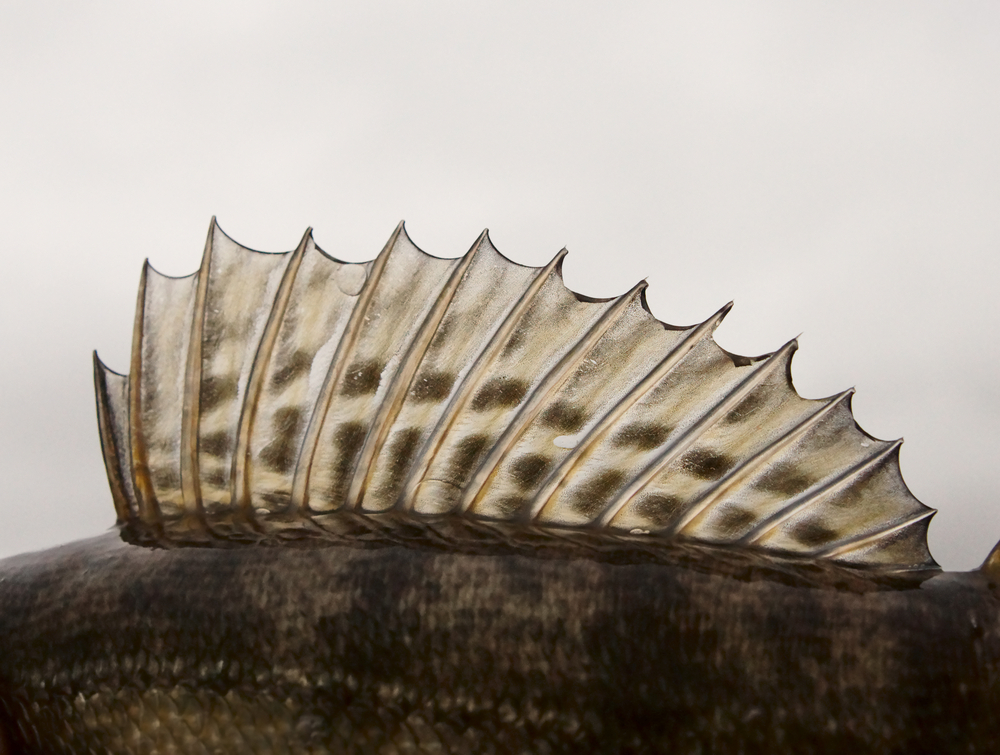
[In this image] A close view of a fish’s dorsal fin.
Image source: R &D world
Scales
Scales are small rigid plates that grow on top of a fish’s skin. A more detailed discussion of fish scales is in this post below.
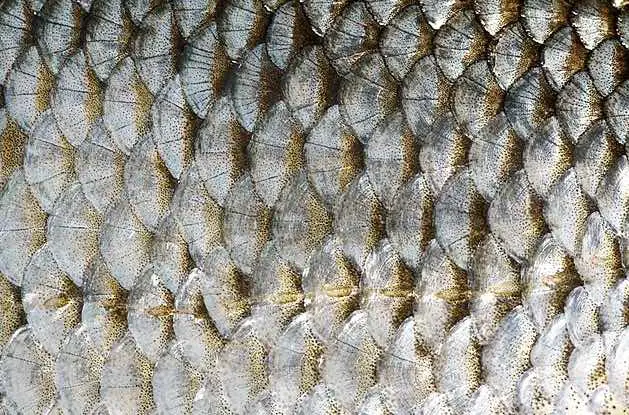
[In this image] The overlapping scales of a roach fish.
Image source: wiki
Gills
Fish breathe by obtaining oxygen from the water flowing through the gills. The gills have many blood vessels, which gives them their bright red color. An operculum (gill cover) is a flexible bony plate that protects the sensitive gills. Water is “inhaled” through the mouth, passes over the gills, and is “exhaled” from beneath the operculum.
Nares
Paired nostrils, or nares, in fish are not for breathing. They are used to detect odors in the water and can be pretty sensitive.
Lateral Line
The lateral line is a sensory organ with a series of pores along the side of the fish. The lateral line can sense the movement of water currents and the water pressure.
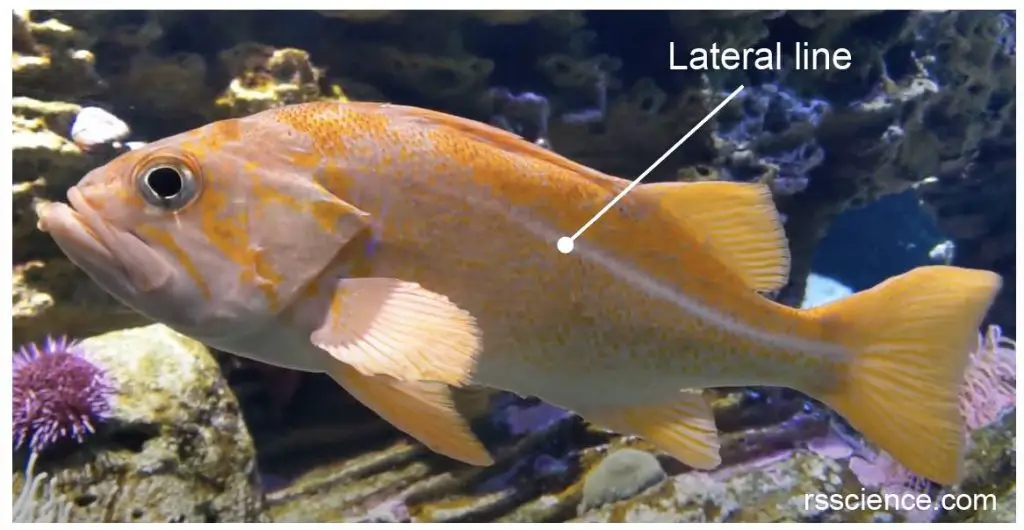
[In this image] Lateral Line.
Swim bladder
The swim (or air) bladder is a hollow, gas-filled balance organ allowing a fish to maintain neutral buoyancy (suspending) in water.
What are fish scales? – Are they bone?
Fish scales grow out of the skin of fish. They are NOT a part of fish’s skeleton or bone system. Fish scales are produced from the inner layer of fish’s skin. In fact, fish scales are closer to our hair. The same genes involved in tooth and hair development in mammals are also involved in the growth of fish scales.
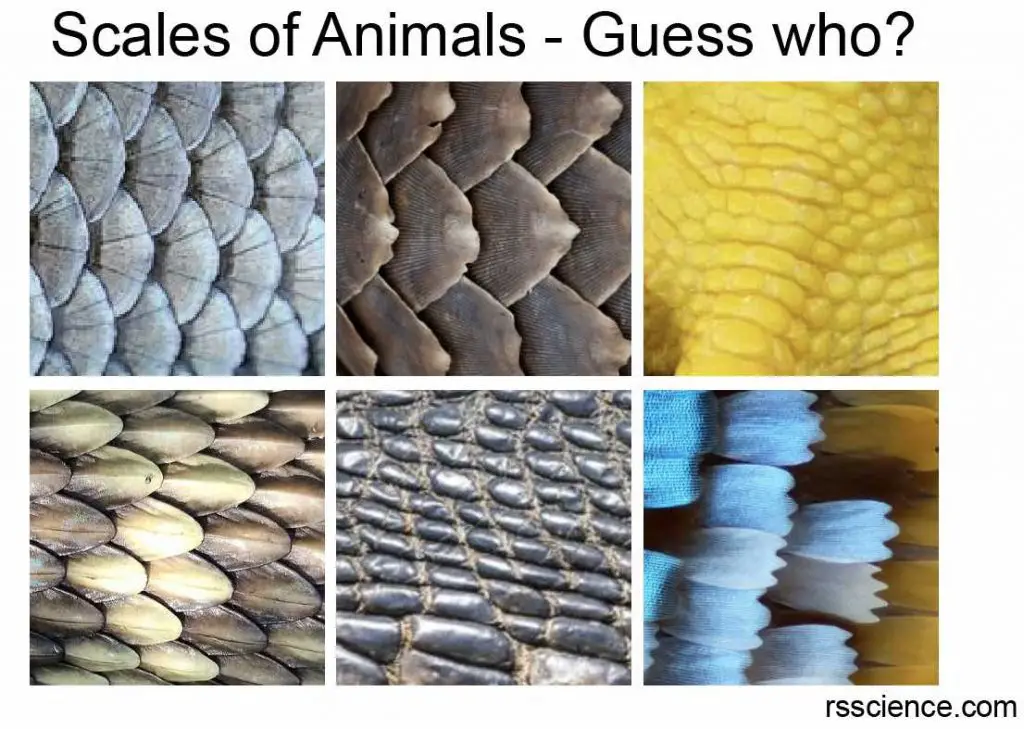
[In this image] Many animals have their bodies covered with scales. Can you guess who owns these scales? See answers by the end of this article.
Fish scales are made of both inorganic (hydroxyapatite, calcium phosphate, etc.; same as our bone and teeth) and organic components (collagen, fat, various vitamins, and proteins). Inorganic materials form the surface layer of the scales. The inner sides of the scales (closer to the skin) are rich in collagen.
Why are fish so slippery?
On top of their scales, most fish are also covered in a layer of mucus/slime. This slippery coat can protect fish against pathogens such as bacteria, fungi, and viruses. It also reduces surface resistance when fish swim.
Why does a fish have scales? – Functions of fish scales
These plate-liked scales have various functions:
Protection
Fish scales protect the skin from attacks by predators, parasites, and other injuries. Scales are positioned atop the next so that they can slide one against the other: they form a sort of soft armored protection, which can be freely distorted when the fish is moving (like a coat of mail worn by medieval knights).

[In this image] Medieval scale armor is an example of ancient bio-inspired or biomimetics technology.
Image credit: Armor Venue
Reflecting light
Many fishes are covered with highly reflective scales, which function as small mirrors and give the appearance of silvered glass. These scales can provide a transparency effect, making the fish invisible to the predators.

[In this image] The scales of a typical teleost fish, such as Atlantic mackerel (pictured) or herring, are silvered.
Image credit: NOAA
Hydrodynamic
The smooth surfaces of fish scales also have a hydrodynamic function to reduce water friction and resistance and to facilitate forward motion.
[In this video] Fish scales are smooth to help them glide through the water, and some reflect light to help camouflage them underwater. You can see the school of fish fading into the blue background.
Video: taken at the National Museum of Marine Biology & Aquarium, Pingtung, Taiwan.
Although scales provide so many advantages for fishes; however, there are some fish without scales. We will see some examples below.
Types of fish scales
Different fishes have different types of scales. There are five major types of scales: (1) Placoid, (2) Ganoid, (3) Cycloid, (4) Ctenoid, and (5) Cosmoid. Cycloid and ctenoid scales are the most frequently encountered in bony fishes. Each scale type also has numerous variations. Types of scales also correspond to the evolutionary relationships of fishes.
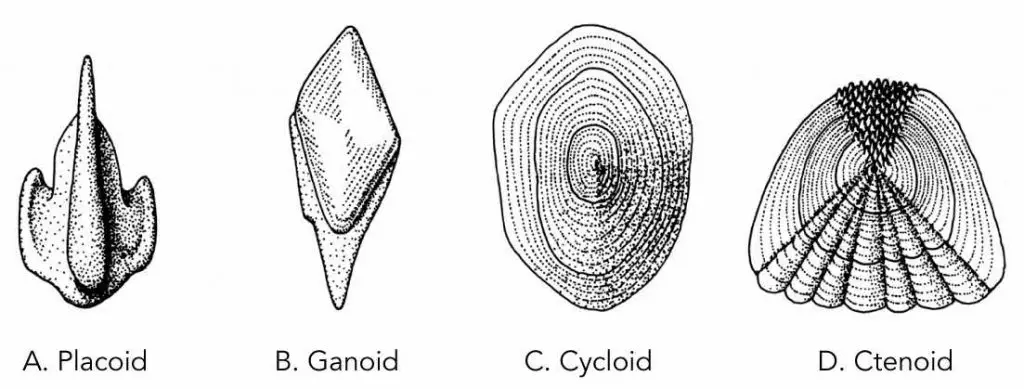
[In this image] Four types of fish scales A) Placoid, B) Ganoid, C) Cycloid, and D) Ctenoid
Image from Living Ocean, CRDG, University of Hawaii at Manoa
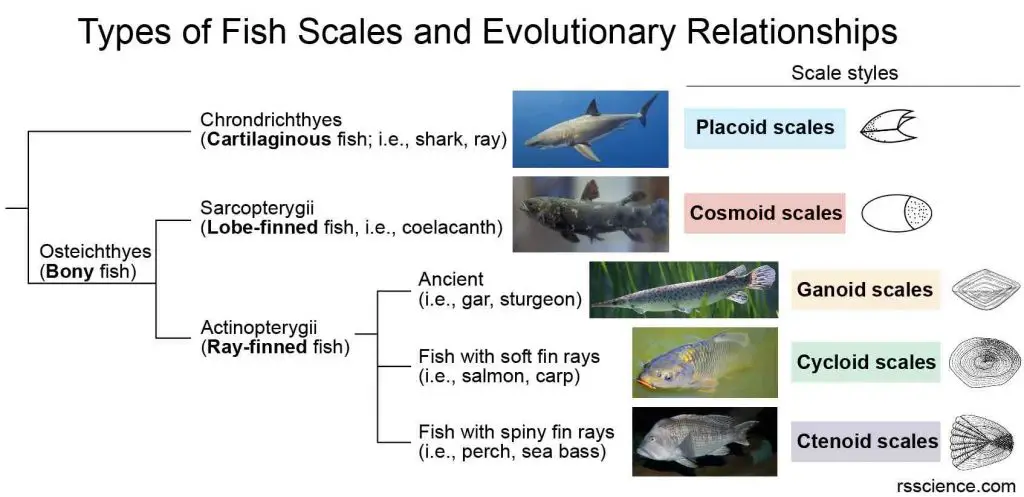
[In this image] The change of scale types along the evolutionary relationships of fishes. For the details of each scale type, see below.
Placoid scales
Placoid scales are found in sharks and rays. Placoid scales have a flattened base with a spine protruding toward the fish’s tail. These scales are often called dermal denticles because they are made from dentin and enamel, similar to our teeth’ material.
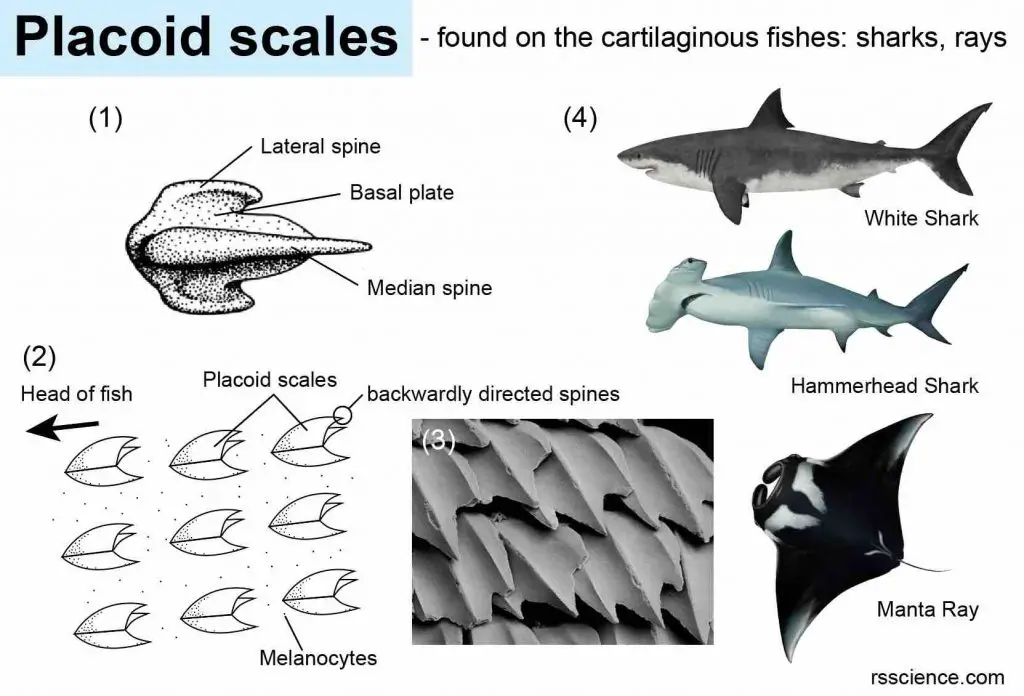
[In this image] Placoid scales are found on cartilaginous fishes, like sharks and rays.
(1) Structure of Placoid scales – a flattened base with a spine. (2) These spines point towards the rear of the fish. (3) Scanning electron microscope (SEM) image of placoid scales. (4) Examples of sharks and rays.
Images: modified from NOAA
Small placoid scales almost entirely cover shark skin. When the water flows through these placoid scales, the spines can create tiny vortices that reduce hydrodynamic drag and turbulence, making swimming more efficient and quieter than bony fishes. This is one of the reasons that makes sharks the top predators in the ocean.

[In this image] Sharkskin cover is an example of biomimicry design.
Scientists have replicated the dermal denticles on swimsuits and the bottom of ships or boats. The reduction of hydrodynamic drag makes swimmers and cargo boats faster. Sharkskin-inspired swimsuits received a lot of media attention during the 2008 Summer Olympics when the spotlight was shining on Michael Phelps. However, these swimsuits are now banned in most major competitions.
Ganoid scales
Ganoid scales are found only on some bony fishes, including gars, paddlefishes, sturgeons, bowfin, and bichirs. Ganoid scales are characterized by a glassy, multi-layered mineralized tissue that covers the scales – called Ganoine. Some ganoid scales have a jagged or sawlike edge. In the sturgeons, ganoid scales become enlarged, armor-like body plates called scutes. Ganoid scales are also commonly found in ancient ray-finned fishes (in fossils).
Most ganoid scales are diamond-shaped and connected by peg-and-socket joints. They are thick and fit together more like a jigsaw rather than overlapping like other fish scales. This way, ganoid scales are nearly impenetrable and provide excellent protection against predation.
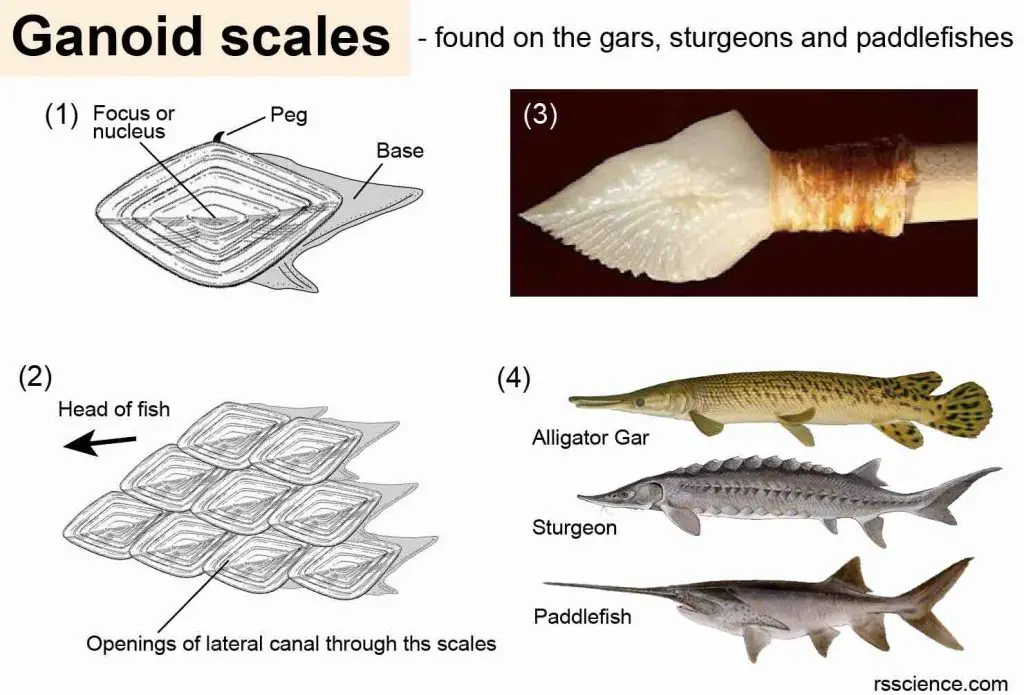
[In this image] Ganoid scales are found on gars, paddlefishes, and surgeons.
Many of them are considered “living fossils” of ancient bony fishes. (1) Structure of Ganoid scales – mostly diamond-shaped. (2) Ganoid scales are connected by peg-and-socket joints. (3) An arrowhead made of Alligator gar scale. (4) Alligator gar, sturgeon, and paddlefish.
Image source: modified from Kentucky department of fish and wildlife resource, Texas parks & wildlife
Native Americans used the tough ganoid scales of the alligator gar for arrowheads, breastplates, and shielding to cover plows. Even now, some jewelry is made from these scales.
Cycloid scales
Cycloid (meaning circular) scales have an oval shape, smooth texture, and are uniform, with a smooth outer edge or margin. They are most common on fish with soft fin rays, such as salmon, trout, and carp.
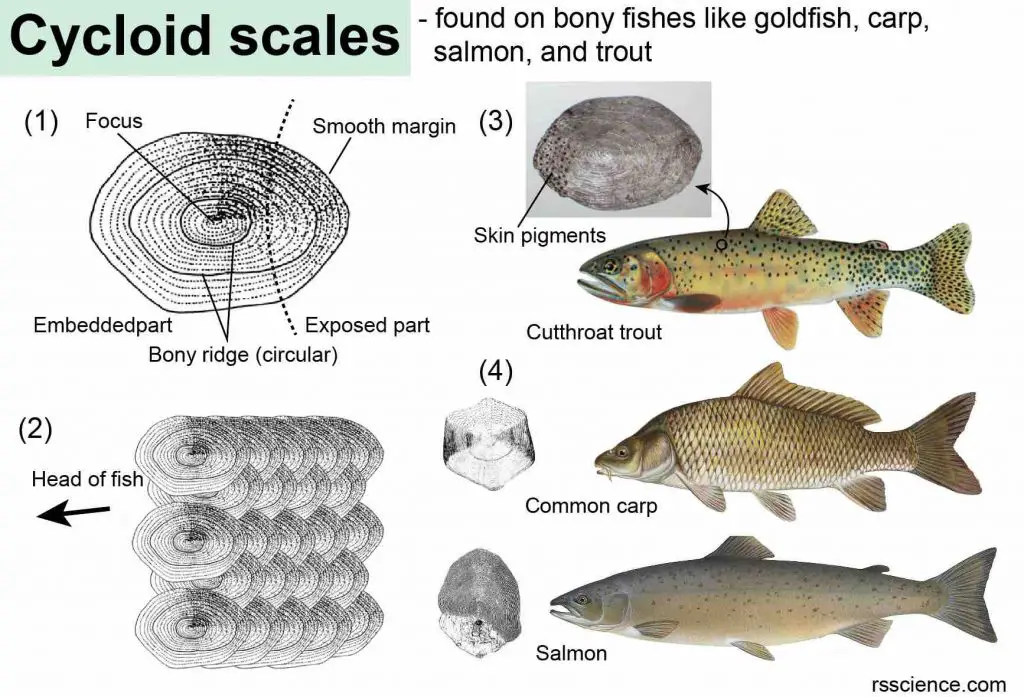
[In this image] Cycloid scales are found on fish with soft fin rays, such as trout, carp, and salmon.
(1) Structure of Cycloid scales – oval shape with a smooth edge. (2) Cycloid scales cover the skin of fish like overlapping roof tiles. (3) An example of cycloid scales from trout. (4) Carp and salmon.
Image source: modified from wild trout trust, UT Austin biodiversity center, Pacific streamkeepers federation
Ctenoid scales
Ctenoid (meaning toothed) scales are like cycloid scales, except they have small teeth or spinules called ctenii (singular: ctenus) along their outer edges. Because of these teeth, the scales have a rough texture. Ctenoid scales are also commonly clam-shaped. Ctenoid scales are usually found on fishes with spiny fin rays, such as perch-like fishes.
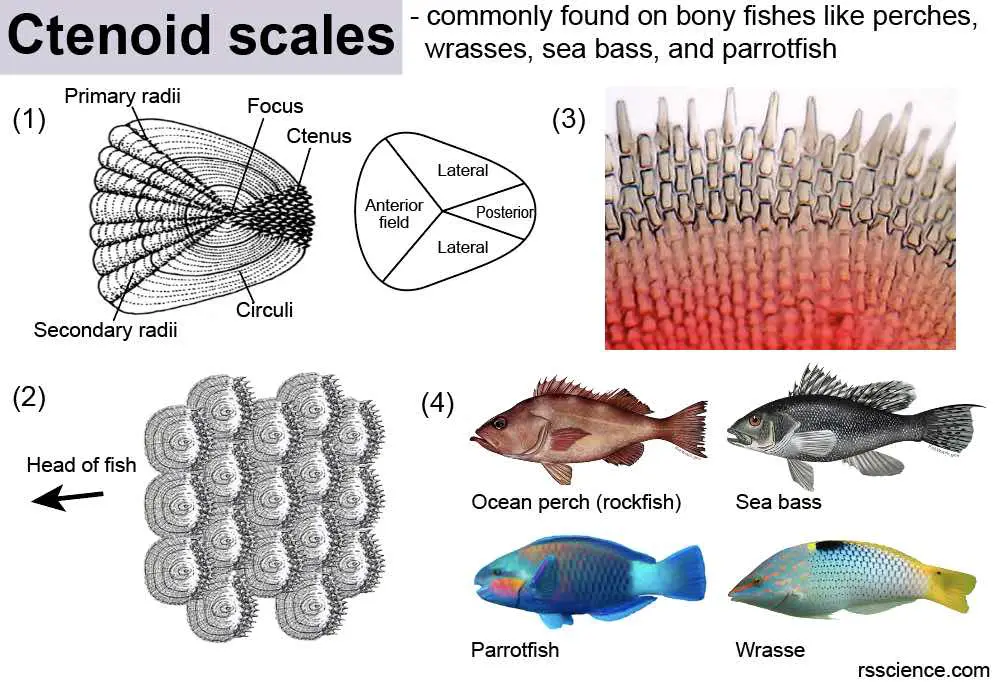
[In this image] Ctenoid scales are the most common type of fish scales and are found on fish with spiny fin rays.
(1) Structure of Ctenoid scales – clam-shaped with rings, radii, and rough ctenus. A ctenoid scale can be divided into four fields. (2) Ctenoid scales shield by overlapping. The posterior fields with spiny ctenii are exposed, giving these fishes a rough texture. (3) Microscopic image of ctenii. (4) Examples of perch, sea bass, parrotfish, and wrasse.
Images: modified from NOAA, Brightfield Digital Image Gallery
Cycloid and Ctenoid scales are the most commonly found scale types in most bony fishes. They are also called Leptoid (bony-ridge) scales. These scales can overlap like shingles on a roof, giving the fish more flexibility. These scales also form growth rings like trees that can be used for determining fish age. Some flatfishes, like flounders, have both cycloid and ctenoid scales.
Cosmoid scales
Cosmoid Scales are rare and found only on ancient lobe-finned fishes, including some of the earliest lungfishes (subclass Dipnoi), and in subclass Crossopterygii, including the living fossil coelacanth. Cosmoid scales are a fusion of placoid-ganoid scales. They are much bigger and thicker than other fish scales. There are spongy bones supplied with blood vessels inside the cosmoid scales.
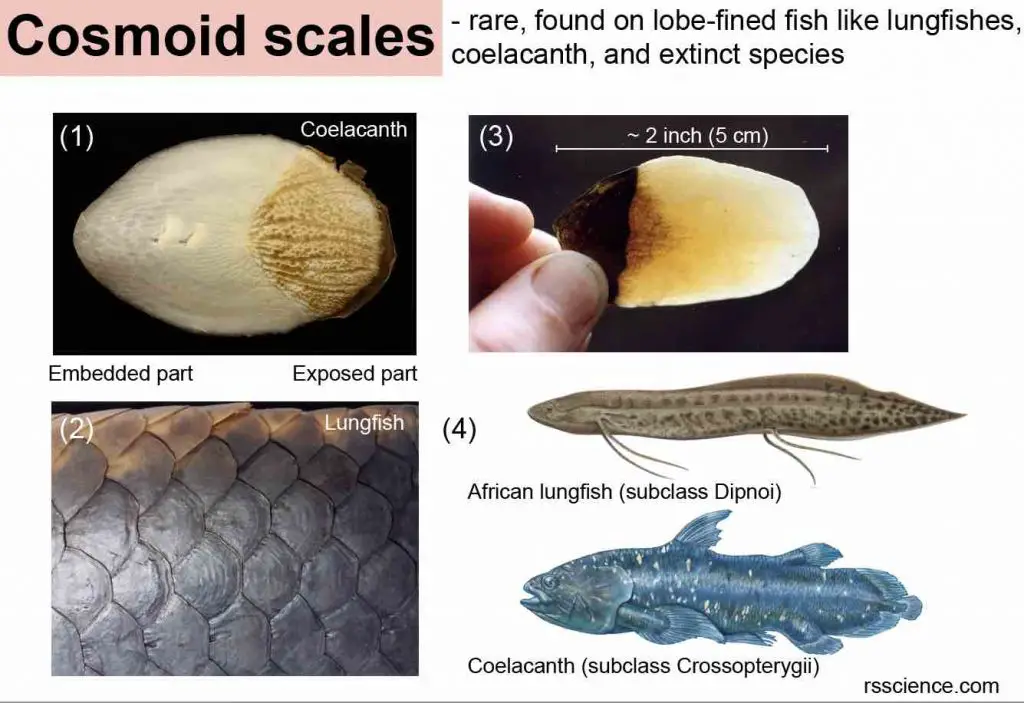
[In this image] Cosmoid scales are only found on ancient lobe-finned fishes, and most of them were extinct.
Examples of living species are lungfish and coelacanth. (1) A cosmoid scale from coelacanth (Latimeria chalumnae). The pearly part is embedded, being overlapped by other scales. (2) Cosmoid scales of Australian lungfish. (3) This giant coelacanth scale is about 2 inches or 5 cm long. (4) Lungfish and coelacanth.
Image source: modified from Australian museum, Britannica, Britannica (2), PBase
Modified scales
Some fish scales evolved to serve various functions. Examples of these modified scales are:
Most fishes have a lateral line as a sensory organ to detect water movements. To do so, the scales along the lateral line have central pores that allow water to contact the sensory cells.

[In this image] The pores on the scales along the lateral line.
Image credit: the spruce pets
The external spines on the porcupinefishes are modified scales.
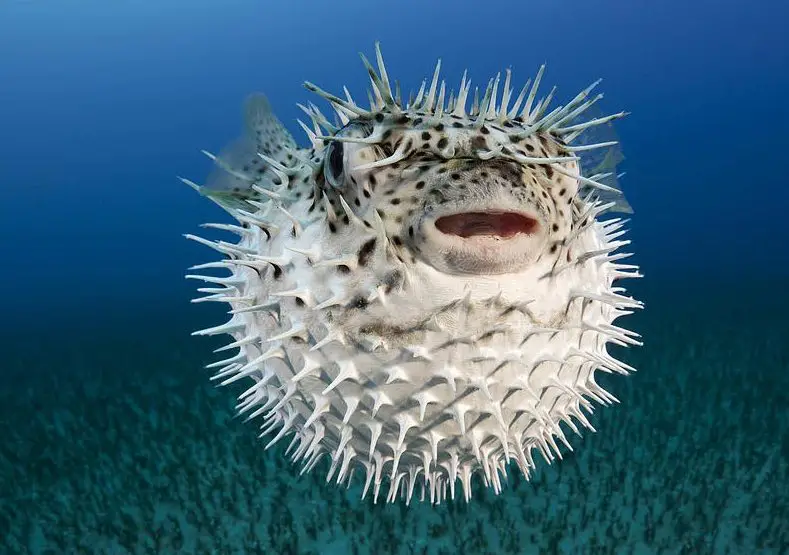
[In this image] Porcupinefish have a very elastic stomach and fill it out with water like a balloon when threatened.
Image credit: the parody wiki
The dorsal fin spines of dogfish sharks and chimaeras, the stinging tail spines of stingrays, and the “saw” teeth of sawsharks are all fused and modified placoid scales.

[In this image] Clockwise from top left: dogfish shark, stingray, sawshark, and chimaera.
Image credit: azanimals, wiki
Fish without scales
Some fishes are totally scaleless, such as Torpedo (electric-ray) and catfishes. Fish without scales usually evolve alternatives to replace the protective functions of scales, such as tough leathery skin or bony plates. Here are some examples:
Jawless fish (lampreys and hagfishes) have smooth skin without scales. Lampreys get some protection from their tough leathery skin. Hagfish produce mucus when they are threatened. They can also tie themselves in an overhand knot to escape from predators.

[In this image] Threatened hagfish tie themselves in an overhand knot.
Image credit: Jonathan Simon
Most eels are scaleless. Some species have tiny cycloid scales embedded in their skins.
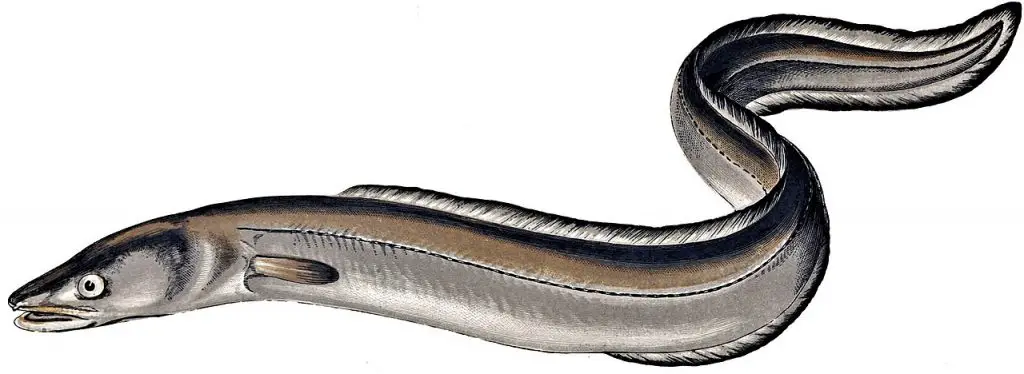
[In this image] Eels have an elongated, scaleless body.
Image credit: wiki
Most catfish are scaleless, though several families have body armor.
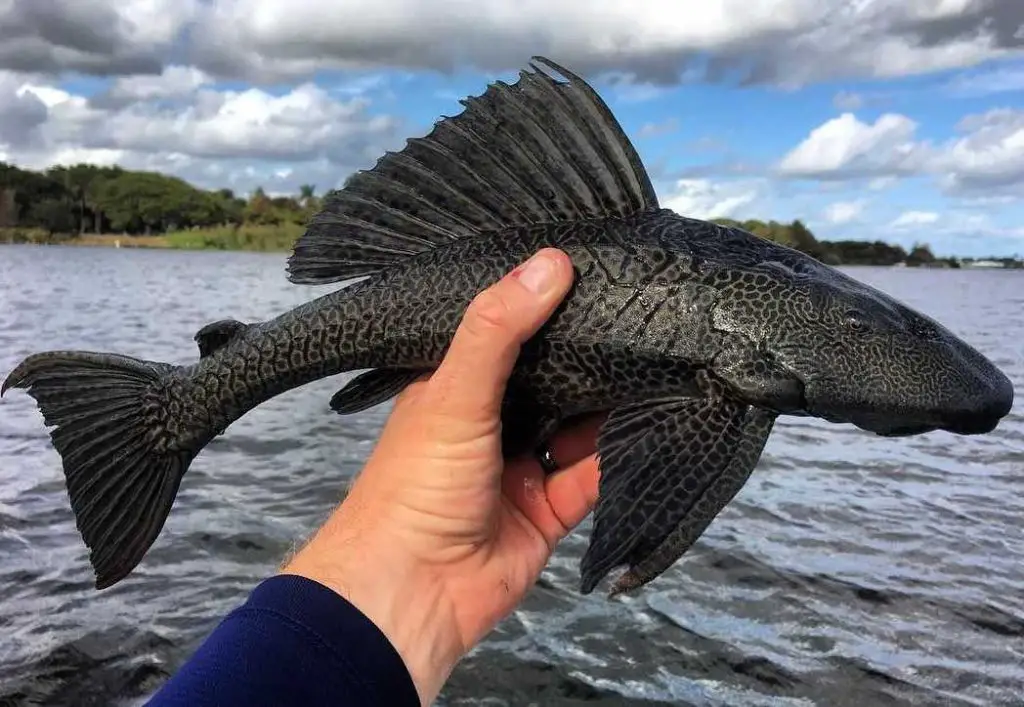
[In this image] Armored catfishes (Family Loricariidae) are noted for the bony plates covering their bodies and their suckermouths.
Image credit: Seafish
Activity: Look at Fish Scales under the microscope
This section will go straight to look at fish scales under a microscope. You may encounter some concepts or terms that you are not familiar with. If so, you can follow the links, jump back to previous sections to learn more about fish biology, or see the functions, structures, and types of fish scales.
Materials
- Forceps
- Specimen containers
- Microscope slides
- Dissecting microscope or hand magnifier
Where to get fish scales?
You can find many different kinds of fishes in a supermarket or fish shop. You may ask the store to see if they can give you some fish scales or allow you to collect them by yourself. Of course, you won’t have any fish scales if you buy a processed fish fillet. You have to try the intact, unprocessed fish.
Scales from pet fishes are usually too small for us to study. So don’t harm them.
If you or your family like fishing, it is a great opportunity to collect fresh fish scales from your catch.
People will scrape fish scales with a scale remover or knife to quickly clean the fish scales. However, this step may damage the fish scales, especially the delicate structures such as the ctenii on ctenoid scales. Therefore, you might want to use forceps to collect fish scales directly from fish skin.
Wash the fish scales and observe them as soon as you can. If you want to preserve some specimens, keep them in a refrigerator. Otherwise, they could smell bad quickly.
Things to do
A. Examine the fish scale under a dissecting microscope or magnifier.
Place the fish scale on a microscope slide and examine it under a dissecting microscope or magnifier. Look for rings, spikes, edges, particles, and other structures.
B. Draw the fish scale and describe it.
Make a note of the size, shape, thickness, and details of your fish scale.
C. Identify the types of scales.
Use the knowledge you learn from this article as a reference to identify the types of scales. Explain your identification.
D. Compare fish scales from different parts of the fish (like near the head or tail).
1. How does the size and thickness of the scales vary across the body of the fish?
2. What other similarities or differences do you notice between the scales on different parts of the fish body?
E. Compare fish scales from different fishes.
1. Which fish has bigger scales?
2. Which fish has thicker scales?
3. What other similarities or differences do you notice?
4. Do you encounter a fish with unique scales or no scale?
Activity Questions:
- Can you tell the evolutionary relationship of your fish by studying its scale types?
- How might scales on a fish be used in protection?
- Do you find fish scales with color?
- Why do you think some fish have large scales and others have small scales?
- Why do you think some fish have no scales at all?
- If a fish scale makes rings as it grows, how might the rings be used to estimate the age of the fish?

[In this image] Beautiful ring patterns on a Sea Bass’s scales that I bought from my local Costco.
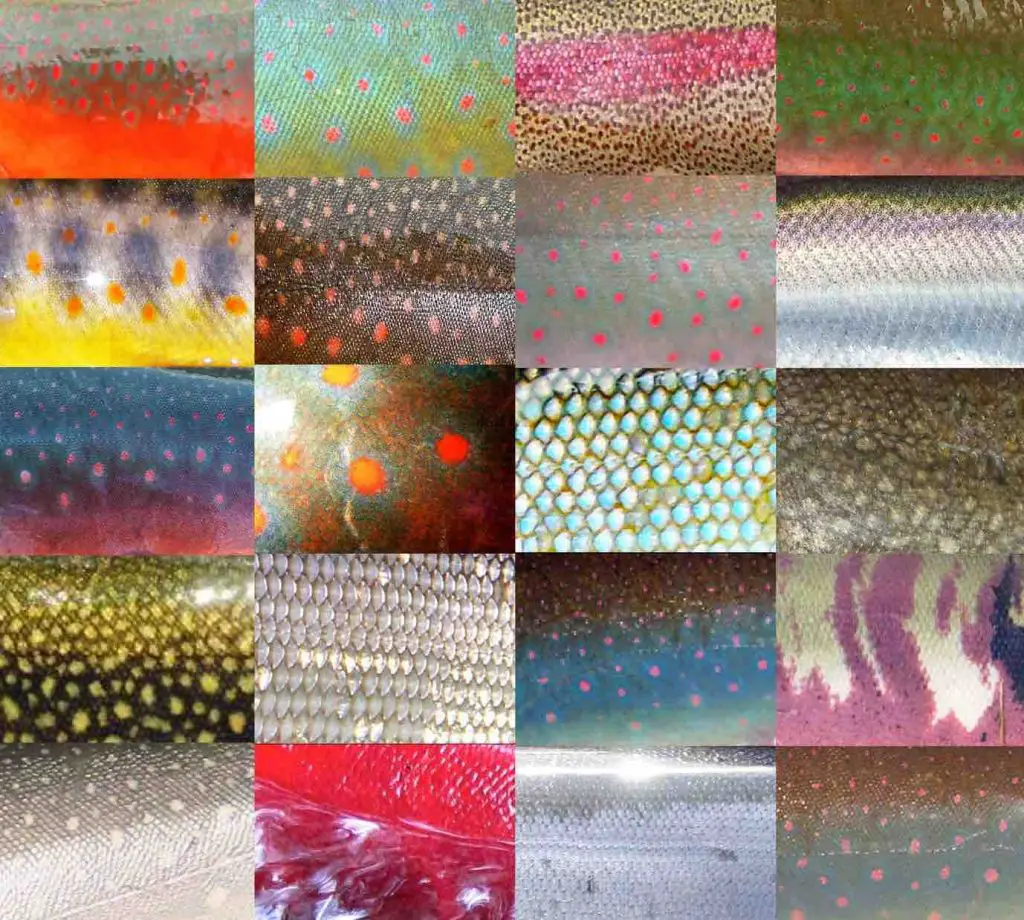
[In this image] Fish are absolutely beautiful. Their color can come from both the pigment cells in their skin and pigment particles in their scales.
Image source: Fish Scales by Katrina Liebich, U.S. Fish and Wildlife Service.

[In this image] Pigment cells under a light microscope in the skin of brown trout.
Image source: Ida Djurdjevič et. al., J of Anatomy, 2015
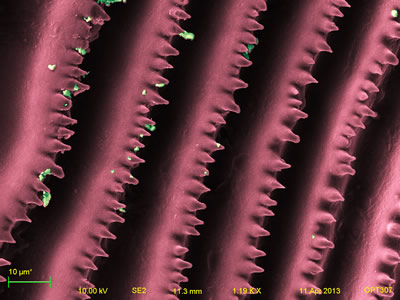
[In this image] More detailed structures of fish scales require advanced microscopy. For example, a red snapper scale shows a striped pattern with teeth under a scanning electron microscope (SEM).
Image source: scale up the scale
The science of studying fish scales
Like we divided fishes into groups according to the structures of their scales, the use of fish scale morphology for fish classification, also known as lepidology, can be traced back to the middle of 19 century.
Famous Swiss-born American biologist and geologist Louis Agassiz was the first to use fish scales for taxonomy. In his work, he divided fishes into four groups according to the structures of their scales: Placoidei, Ganoidi, Ctenoidei, and Cyloidei. Agassiz was the founder of the Harvard Museum of Comparative Zoology and a Harvard professor. He collected many important fish fossil specimens. He also proposed the idea of “Ice Age” in the history of Earth.

[In this image] Louis Agassiz in 1870.
Image source: wiki
You may like to read the wonderful anecdote titled “The Student, the Fish, and Agassiz”. It is a story showing the importance of first-hand observation in the learning of science.
How to determine fish age through microscopy?
The typical way to estimate the age of a fish is by its size. However, this is not a precise method, especially for a new species we know very little about. Through microscopy, analysis of bones and scales can reveal growth rings that help identify the age of the fish.
Ear stone (otolith) is the most commonly used structure for determining the age of fish in a laboratory. Only bony fish have ear stones. Each fish has three pairs of ear stones in the fish’s inner ear, allowing fish to hear and sense vibrations in the water. Ear stones also provide a sense of balance, so fish can better navigate their surroundings.
Ear stones grow throughout a fish’s life by adding new outer layers around a core. This creates alternating layers: opaque or translucent based on their optical properties. In summer, fish feed actively (more food sources) and produce a wide opaque layer on their ear stones. When the fish eat less during the winter, the ear stones grow slowly and gain a narrower translucent layer. The two layers, the translucent and opaque, together represent one year of growth, called an annulus (same as annual rings in trees).

[In this image] A ear stone from a two-year-old Sand lance. The opaque and translucent growth rings are labeled. Black dots indicate the location of the annuli.
Photo source: NOAA Fisheries.
For some species, fish scales may be used to determine age. In this case, the concentric ridges on the scale will be wider in summer and closer together during winter. Note that it is not for one ring on the scale representing one-year growth. In fact, fish can grow several scale rings in a few months.
Determining the exact age of fish by their scales is difficult. For example, fish scales can erode on the edges, shed, and regenerate. The erosion can lead to falsely low age readings and inaccurate data.
Sharks’ placoid scales do not have rings. Sharks also lack ear stones. For this reason, scientists usually use sharks’ vertebrae bones to determine their ages.
Answers for “Scales of Animals – Guess who?”
Clockwise from top left: Fish, Pangolin (mammal), Sea eagle’s feet (bird), Butterfly (insect), Alligator (reptile), Snake (reptile).
Summary
1. Fishes are aquatic vertebrate animals. They have a central backbone to support their bodies and breath by the gills.
2. We can simply divide fishes into three groups: jawless fishes (lampreys and the hagfish); cartilaginous fishes (sharks, skates, rays, and chimaeras); bony fishes (the vast majority of fish).
3. Common exterior features of fish include fins, scales, eyes, nares, and lateral lines.
4. Common interior features of fish include brain, gills, heart, liver, intestine, spinal cord, and swim bladder.
5. Fish scales are produced from the inner layer of fish’s skin. In fact, fish scales are closer to our hairs.
6. Fish scales are made of both inorganic (hydroxyapatite, calcium phosphate, etc.; same as our bone and teeth) and organic components (collagen, fat, various vitamins, and proteins).
7. The function of the fish scale includes protection, reflecting light, and reducing water friction.
8. Five major types of scales: (1) Placoid (sharks and rays), (2) Ganoid (gars, paddlefishes, and surgeons), (3) Cycloid (trout, carp, and salmon), (4) Ctenoid (most common type of fish scale), and (5) Cosmoid (ancient lobe-finned fish). Types of scales also correspond to the evolutionary relationships of fishes.
9. Ear stone (otolith) is the most commonly used structure for determining the age of fish in a laboratory.
References
“How a spectacular fossil fish revealed the origin of digits in vertebrates”
“Structure and Function – Fish”
“Activity: Observing Fish Scales”
“Age and Growth”

